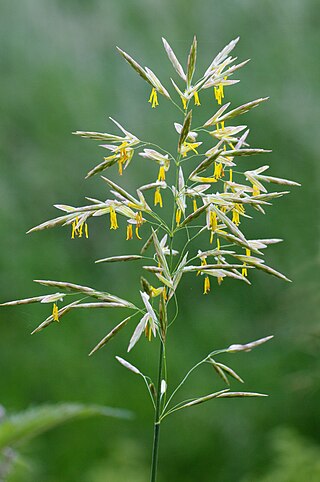
Bromus tectorum, known as downy brome, drooping brome or cheatgrass, is a winter annual grass native to Europe, southwestern Asia, and northern Africa, but has become invasive in many other areas. It now is present in most of Europe, southern Russia, Japan, South Africa, Australia, New Zealand, Iceland, Greenland, North America and western Central Asia. In the eastern US B. tectorum is common along roadsides and as a crop weed, but usually does not dominate an ecosystem. It has become a dominant species in the Intermountain West and parts of Canada, and displays especially invasive behavior in the sagebrush steppe ecosystems where it has been listed as noxious weed. B. tectorum often enters the site in an area that has been disturbed, and then quickly expands into the surrounding area through its rapid growth and prolific seed production.

Bromus is a large genus of grasses, classified in its own tribe Bromeae. They are commonly known as bromes, brome grasses, cheat grasses or chess grasses. Estimates in the scientific literature of the number of species have ranged from 100 to 400, but plant taxonomists currently recognize around 160–170 species.

Bromus ramosus, the hairy brome, is a bunchgrass in the grass family Poaceae, native to Europe, northwest Africa and southwest Asia. The name Bromus comes from the term brome, meaning oats. Unlike most other bromes, it grows in shady sites under trees.

Bromus hordeaceus, the soft brome, is an annual or biennial species of grass in the grass family (Poaceae). It is also known in North America as bull grass, soft cheat, and soft chess.

Bromus diandrus is a species of grass known by the common names great brome and "ripgut brome".

Bromus commutatus, the meadow brome, is an annual or biennial species of plant in the grass family Poaceae. In the United States it is known as hairy chess.

Bromus inermis is a species of the true grass family (Poaceae). This rhizomatous grass is native to Europe and considered invasive in North America.

Bromus erectus, commonly known as erect brome, upright brome or meadow brome, is a dense, course, tufted perennial grass. It can grow to 120 centimetres (47 in). Like many brome grasses the plant is hairy. The specific epithet erectus is Latin, meaning "erect". The diploid number of the grass is 56.

Bromus sitchenis, the Alaska brome, is a perennial grass native to the North Pacific coast of North America, in woods and banks from Alaska to Oregon. It can grow up to 1.8 m tall, but is often shorter. Leaf blades are elongate, 7–12 mm wide, and as much as 35 cm long. Spikelets 2.5 to 3.5 cm long with between 6 and 12 flowers, awn is 5 to 10 mm long.

Bromus auleticus is a species of flowering plant in the brome tribe, Bromeae, of the grass family Poaceae. It is native to the Pampas of northern Argentina, Uruguay and southern Brazil. It is in the process of being domesticated for fodder use.

Bromus lanceolatus, the Mediterranean brome, large-headed brome or lanceolate brome, is a species of flowering plant in the family Poaceae. It is native to the Mediterranean, the Middle East, the Caucasus, Central Asia, Xinjiang in China, Afghanistan and Pakistan. A tetraploid, it does well in disturbed habitats and has been introduced to scattered locations in North America, South America, and central Europe.

Bromus racemosus, the smooth brome or bald brome, is a species of flowering plant in the family Poaceae. It is native to subarctic and temperate Eurasia, and widely introduced elsewhere, including North America, Iceland, the Southern Cone of South America, the Korean Peninsula, Australia, and New Zealand. It grows in alkaline meadows and in waste places.

Bromus scoparius, the broom brome, is a species of flowering plant in the family Poaceae. It is native to the Mediterranean, Crimea, the Middle East, the Caucasus region, Central Asia, Xinjiang in China, and on to the northwest Indian Subcontinent, and has been introduced to Chile, California, a few locales in the eastern US, and southeast China. A somewhat weedy annual, it prefers to grow in grasslands.

Bromus lepidus, the slender soft brome, is a species of flowering plant in the family Poaceae. It has a disjunct distribution, native to central and northern Europe, and Xinjiang in China, and introduced to an assortment of other locales, including some northeast states of the United States, the Canary Islands, and Egypt. The taxonomic history of this species has been marked by nomenclatural issues.
Bromus tomentellus, the wooly brome, is a species of flowering plant in the family Poaceae, native to Crete, Turkey, the Caucusus, the Levant, Iraq, Iran, and Turkmenistan. It is a regionally important livestock forage species.

Bromus grossus, the whiskered brome, is a species of flowering plant in the family Poaceae. It is native to central Europe, and has been introduced to Great Britain, and New York and Oregon in the United States. It has gone extinct in the Netherlands. During the Neolithic it arose as a weed of spelt fields, and due to changing agricultural practices is now considered highly endangered under the Habitats Directive.

Bromus biebersteinii, the meadow bromegrass or just meadow brome, is a species of flowering plant in the family Poaceae, native to the Caucasus, Iraq, Iran and Afghanistan. It has been developed as a forage in North America and there are a number of cultivars available, including 'Arsenal', 'Cache', 'Fleet', 'MacBeth', 'Montana', 'Paddock' and 'Regar'.
Bromus intermedius, the intermediate brome, is a species of flowering plant in the family Poaceae. It is native to the Mediterranean countries and islands, and eastwards to Afghanistan. It can be found growing on serpentine soils.
















